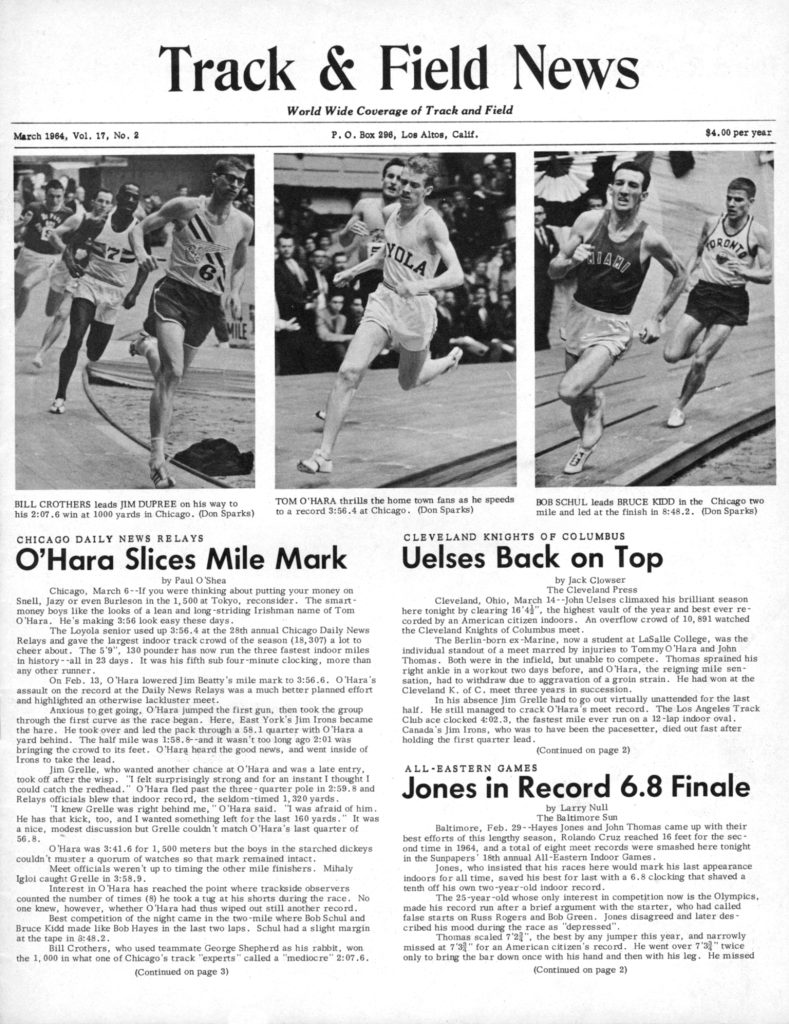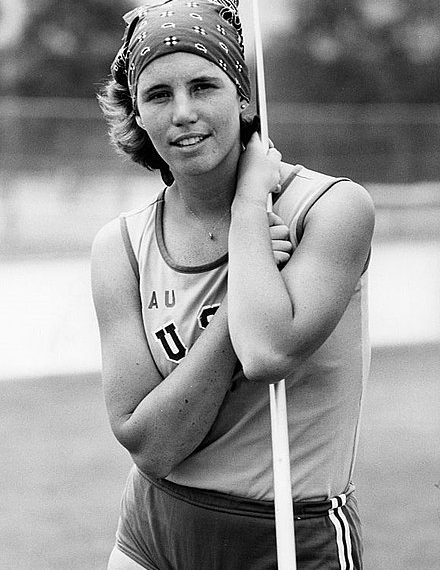Walt Murphy is one of the finest track geeks that I know. Walt does #ThisDayinTrack&FieldHistory, an excellent daily service that provides true geek stories about our sport. You can check out the service for FREE with a free one-month trial subscription! (email: WaltMurphy44@gmail.com ) for the entire daily service. We will post a few historic moments each day, beginning February 1, 2024.
This Day in Track & Field–March 6
RelatedPosts
by Walt Murphy’s News and Results Service (wmurphy25@aol.com), used with permission
1964—A crowd of 18,307, the largest of the season, watched local hero Tom O’Hara run 3:56.4 at the Daily News Relays in Chicago to break his own World Indoor Record in the Mile by .2s. Pressed by Jim Grelle (3:58.9) for most of the race, the senior at Loyola University, frequently tugging at his shorts (as was his custom), waited until the last lap before pulling away to register his 2nd record of the season.
The redhead had previously smashed Jim Beatty’s previous standard of 3:58.6 by a full two seconds at the NYAC meet in New York on February 13. Some observers felt that he might have lowered the record by another two seconds on this night had he not been too concerned about losing to Grelle.
Along with his 3:58.5 at the Knights of Columbus meet in NY on February 27, O’Hara recorded the three fastest indoor times in history in the space of 23 days.

Sports Illustrated Vault:
http://www.si.com/vault/1964/03/16/608429/now-if-ohara-really-tries
1971–The event’s not contested much anymore, but Tom Ulan of Rutgers set the long-standing Eastern Collegiate Record of 1:08.5 for 600 yards at the IC4A Championships at Princeton.
1976—Kate (The Great) Schmidt threw 215-6 (65.68) in Long Beach, California, to set the 8th of her 10 American Javelin records.
Hall of Fame Bio(1994): https://www.usatf.org/athlete-bios/kate-the-great-schmidt
1987–It was only fitting that the inaugural IAAF World Indoor Championships (March 6-8) would be held in the U.S., where the undercover version of the sport had flourished for decades. (The World Indoor Games, a dry-run for the WIC, were held in the Bercy section of Paris in 1985).
The site was the Hoosier Dome in Indianapolis, and Larry Myricks won the gold medal in the Men’s Long Jump on the first day of competition with a leap of 27-0 (8.23m).
Eamonn Coghlan, one of the favorites in the Men’s 1500 meters, fell in his heat after getting tangled up with Germany’s Dieter Baumann and failed to qualify for the final. A protest was filed on his behalf, and referee John Chaplin, after coming into the NBC truck to view video of the race, reinstated Coghlan. A number of countries filed a counter-protest, and Coghlan was eventually ruled out of the final.
IAAF Report:
Sports Illustrated Vault: http://tinyurl.com/SIVault87WIC
1994–This wasn’t another case of a fisherman telling a tall tale about “the one that got away”. This was the L.A. Marathon and Paul Pilkington was filling his then-customary role as the hired rabbit for the race. The only problem was that none of the “elite” runners went with him as he reached the 1/2-way point in 1:04:02, right on schedule.
Feeling good, Pilkington, who had a best of 2:11:13 to his credit, decided to keep going and won the race in 2:12:13. That didn’t sit too well with Italy’s Luca Barzaghi, who crossed the line in 2:12:52, thinking he was the winner.
While some were upset with his unusual decision, Pilkington continued to get work as a rabbit. He told Barbara Heubner in a 2000 article, ”I was actually in more demand, because they knew no matter what I ran, the others were going to go with me.” Pilkington, who represented the U.S. in the marathon at the 1995 World Championships (he didn’t finish), is currently the Women’s Head T&F/X-Country Coach at Weber State.
Aside: Running journalist Tony Reavis was on one of the lead vehicles and asked Pilkington, when it became obvious the rest of the field was far behind him, “What are you hoing to do?”. Pilkington replied, “I’m going to win”.
Reavis: https://www.youtube.com/watch?v=yZxV7_QwomU
Weber State: https://weberstatesports.com/coaches.aspx?rc=364&path=track
1994–Great Britain’s Colin Jackson ran 7.30 at the European Indoor Championships in Sindelfingen, Germany, to set a World Record in the 60-meter hurdles. Jackson had equaled Greg Foster’s then-record of 7.36 a month earlier. The reigning World Champion in the 100m Hurdles (and 1988 Olympic silver medalist), rated the race as #3 on his all-time top-10 list of performances.
“This world record is virtually impossible to get. It was the only time ever in my career that I was actually trying to break the world record. I was ecstatic when I did that. To run “7.29” over the hurdles is ridiculously quick. To put it into perspective, I ran 7.43 in 2002 and still finished top of the world rankings. “I remember crossing the line and looking at the clock. All I could see was ‘8’ [the time was adjusted up from 7.28 to 7.29, but later amended to 7.30] and said to my training partner Mark McKoy I couldn’t believe I’d run 7.38 again. He said to me: ‘Look at the clock again, really look at it.’ I was kind of excitable after that.” (Grant Holloway ran a “ridiculously quick” 7.29 in Madrid on February 24, 2021, to break Jackson’s Record!)
Personal Top-10: https://www.theguardian.com/sport/2003/mar/14/athletics
1999–Jeff Hartwig finished 2nd to France’s Jean Galfione (19-8 ¼ [6.00]) in the Pole Vault at the World Indoor Championships in Maebashi, Japan, but came away with a consolation prize of an American Record clearance of
19-6 ¼ (5.95).
Galfione’s win wasn’t without controversy.
From the IAAF report: Controversy struck the 7th World Indoor Championships on the second day, as Olympic pole vault champion Jean Galfione came away with a win which will be discussed for many months or more.
The handsome French model became only the fourth vaulter in indoor history to scale the six-meter barrier with a second-attempt clearance of 6.00. His jump appeared to snatch victory from Jeff Hartwig of the US, who had taken the lead with 5.95.
However, after Galfione’s jump had been ruled successful by one judge, the international technical official observing the event opined that the jump should not be allowed because Galfione appeared to steady the bar with his left hand as he fell downward toward the pit, in violation of pole vaulting rules (“Volzing”—named for Dave Volz, who perfected the technique).
The judges assigned to the event huddled for a brief discussion but did not agree with that advice. They awarded the jump—plus a gold medal and $50,000–to Galfione. A protest by the US delegation was turned down by the jury of appeals.
“Yes, I touched the bar, but I didn’t replace it as the rule prohibits,” admitted Galfione. “I gave everything I had on that jump. It was the single jump I needed to win. I’ve never used such a stiff pole in my life, and it paid off.”
Hartwig was diplomatic about the decision, even in losing $30,000 and what would have been the first US pole vault title ever in World Championship competition.
“I hate the new pole vault rule [prohibiting hand steadying] as much as anyone. I didn’t get involved with the discussion, though. I was still in the competition at that moment and I wanted to stay focused. I had just made one of the best jumps of my career [at 5.95], and when the competition was held up for ten minutes, it killed the atmosphere. I was ready to jump, but I couldn’t because of the controversy.”
https://www.worldathletics.org/news/news/6m-victory-for-galfione-as-szabo-looks-for-mo





















